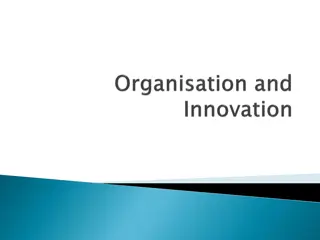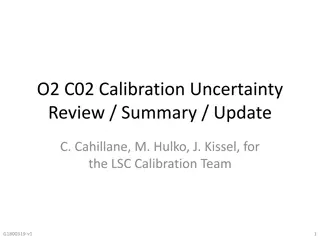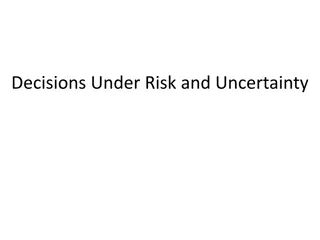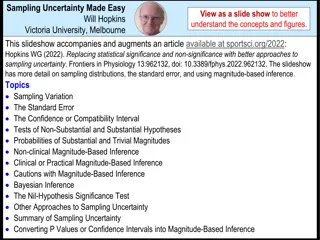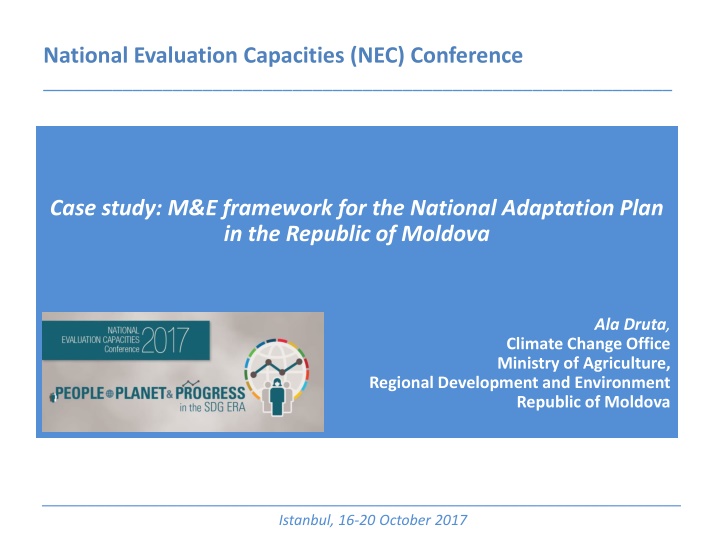
Moldova National Adaptation Plan M&E Framework Case Study
Explore the Monitoring and Evaluation framework for Moldova's National Adaptation Plan, emphasizing the integrated approach to climate change adaptation, institutional arrangements, progress monitoring, and set goals for building resilience against climate impacts.
Download Presentation

Please find below an Image/Link to download the presentation.
The content on the website is provided AS IS for your information and personal use only. It may not be sold, licensed, or shared on other websites without obtaining consent from the author. If you encounter any issues during the download, it is possible that the publisher has removed the file from their server.
You are allowed to download the files provided on this website for personal or commercial use, subject to the condition that they are used lawfully. All files are the property of their respective owners.
The content on the website is provided AS IS for your information and personal use only. It may not be sold, licensed, or shared on other websites without obtaining consent from the author.
E N D
Presentation Transcript
National Evaluation Capacities (NEC) Conference _______________________________________________________________ Case study: M&E framework for the National Adaptation Plan in the Republic of Moldova Ala Druta, Climate Change Office Ministry of Agriculture, Regional Development and Environment Republic of Moldova _______________________________________________________________________ Istanbul, 16-20 October 2017
Republic of Moldova Climate Change Adaptation Policy and Institutional Arrangement ________________________________________________________ National Climate Change Adaptation Strategy (2014) provides for an integrated vision on the development opportunities of the Republic of Moldova to react in a resilient manner to the impacts of climate change. The Climate Change Adaptation Coordination Mechanism (CCACM) established as a cross-sectoral multi-stakeholder mechanism to maintain a sustainable institutional arrangement. National Commission on Climate Change chairsthe CCACM and its mandate includes monitoring progress on adaptation.
Monitoring and Evaluation Framework _________________________________________________________ M&E system goal is to ensure the measurability of progress across sectors, geographic scales, time and to be able to determine whether, as a result of its successive plans, Moldova is less vulnerable to the impacts of climate change. The M&E system will assess and track progress under the successive NAPs/SAPs and serve the purposes: create a set of overarching adaptation goals to which each sector will contribute, measure and monitor the outcomes and impacts of activities, investments, and programmes, including from gender-responsive perspective, track and monitor individual sectoral objectives , targets and indicators, enforce the gradual integration of adaptation priorities in regular development planning, ensure transparency of adaptation process and data collection, allow for iterative and continuous, evidence-based adaptation planning.
Functionality of M&E system aligned to the planning cycle of NAPs and SAPs _______________________________________________________ Communication & knowledge sharing Setting baseline for the adaptation communication NAP baseline Definition of adaptation sectoral and national Evaluation targets evaluation adaptation targets M & E monitoring, reporting adaptation planning Indicator based monitoring Planning for SAPs and NAP
Monitoring component ________________________________________________________ Through the M&E system we will monitor: progress and evaluate impacts of implemented policies, implementation of adaptation related planning, development and dissemination of adaptation related knowledge and research, including guiding material, methodology, tools and instruments, implementation of adaptation technologies and practices, adaptation related financing and investments, including adaptation-related external support received. Levels of monitoring: Micro-level monitoring targeted at assessing the adaptation result of individual actions Meso-level monitoring allows for the tracking of adaptation achievements at the outcome level, Macro-level monitoring is conceived to evaluate or periodically assess the global, cumulative impact of all sectoral adaptation action.
Indicator-based evaluation consists of indicators for tracking and evaluating the success of adaptation planning and interventions: driver indicators: measure the result of actions targeting the drivers of change, including: a) mobilized resources, b) capacity to plan adaptation, c) deep knowledge on climate risks, impact, and vulnerabilities; output indicators: measure the result of adaptation actions included in SAPs; outcome indicators: measure the result of SAPs, reduced sectoral vulnerability and advancing in adaptation; objective indicators: measure the aggregate result of a NAP cycle, the impact on the vulnerability of the Moldovan economy and progress in adaptation.
Indicator-based monitoring system operated through the Information System consists of: a)onlineportal intended for presenting the public information Components Compartments PORTAL Portal management public information: policy documents, reports on assessments, evaluations, description of indicators, communication materials, other and search mode MONITORING and EVALUATION of Public presentation of information b) monitoring platform designed to facilitate data management and monitoring based on templates. CLIMATE CHANGE ADAPTATION MONITORING PLATFORM development of indicators , monitoring and evaluation of indicators by categories, thematic areas PLANNING and IMPLEMENTATIO N Management of monitoring system Indicator -based monitoring
The Tagging of Climate Change Expenditures _________________________________________________________ The purpose of tagging climate related expenditures is to: provide a systemic and replicable process to identify and prioritizes climate related PAPs in budget proposals and allocations, supports the capacity of the MF and MARDE to track CC expenditures and improves their ability to ensure progress on CC toward national development goals and international commitments, supports the development of the financial records to build a climate-financing framework. STEP1 STEP 2 STEP 3 Establish what the PAP and its components will do to address climate change Determine which PAP components have climate relevance Determine the appropriate CCBI for each PAP
Climate Change Budget Indicators and Activity Categories _______________________________________________________ build resilience through a policy and legal framework, to implement CC policy, governance into activity and delivery, diversification and strengthening of CC investment effectiveness CCBI 1 Policy Development and Governance build resilience by developing science & technology as a foundation for formulating policies, assessing impacts and identifying measure on CCA CCBI 2 Research and Development CCBI 3 Knowledge Sharing and Capacity Building build resilience by improving awareness of climate change and developing community capacity to respond to CC build resilience to climate risks by supporting the development of a resilient society, ensuring the development of a low-carbon production economy, ensuring the sustainability of natural resources CCBI 4 Climate Response and Service Delivery
________________________________________________________ Thank you for attention. Contacts: adapt@clima.md drutaala@yahoo.com






